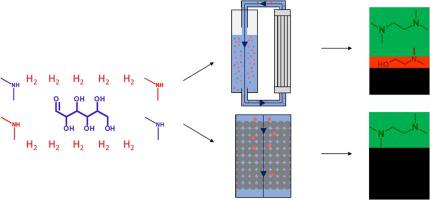Catalysis Today ( IF 5.2 ) Pub Date : 2020-12-24 , DOI: 10.1016/j.cattod.2020.12.006 Jeroen Poissonnier 1 , Annelies Callewaert 2 , Kristof Moonen 2 , Guy B. Marin 1 , Joris W. Thybaut 1

|
Commercial scale jet-loop and trickle bed reactor simulations have been performed for the reductive aminolysis of glucose with dimethylamine (DMA) in combination with an experimental assessment in a (large) lab-scale fed-batch and trickle bed reactor. Based on the intrinsic kinetics of the sequence of homogeneous and heterogeneously catalyzed reaction steps in the reductive aminolysis reaction network, coupled with a different flow pattern and catalyst-to-liquid ratio, significant differences in the yield of N,N,N’,N’-tetramethylethylenediamine (TMEDA) and N,N-dimethylaminoethanol (DMAE) can be expected for both reactor types. Yet, TMEDA is obtained in the highest yields irrespective of the reactor type. In the jet-loop reactor, which is operated overall as a batch reactor, an optimized TMEDA yield up to 57 % is simulated, while a non-negligible yield of DMAE, up to 12 %, is also achieved. The optimized operating conditions are such that they correspond to the high DMA to glucose ratio used during lab-scale fed-batch experimentations, also explaining why the jet-loop product spectrum is almost identical to the latter. This is ensured by the efficient heat-exchange in the jet-loop reactor, which is, in contrast, one of the main bottlenecks for exploitation of the reductive aminolysis in a trickle bed reactor. The second challenge to address in the trickle bed reactor is the limited extent of hydrogen transfer from gas to liquid, which can only be partially overcome by increasing the feed flow rates. While isothermal operation indicates TMEDA yields of about 60 %, non-isothermally simulated TMEDA yields only amount to 40 %. The latter yield loss was also validated experimentally in the trickle bed reactor and confirmed that avoiding degradation reactions remains challenging as it is critical in the reductive aminolysis of glucose.
中文翻译:

葡萄糖还原氨解大规模开采中射流回路与滴流床反应器性能比较
商业规模的喷射回路和滴流床反应器模拟已经结合在(大型)实验室规模的分批补料和滴流床反应器中的实验评估,用二甲胺 (DMA) 对葡萄糖进行还原氨解。基于还原氨解反应网络中均相和非均相催化反应步骤序列的内在动力学,再加上不同的流动模式和催化剂与液体的比例,N,N,N',N的产率存在显着差异'-四甲基乙二胺 (TMEDA) 和N,N-二甲氨基乙醇 (DMAE) 可用于两种反应器类型。然而,无论反应器类型如何,TMEDA 的产率都最高。在整体作为间歇式反应器运行的射流环流反应器中,模拟了高达 57% 的优化 TMEDA 产率,同时也实现了高达 12% 的不可忽略的 DMAE 产率。优化的操作条件使得它们对应于实验室规模的分批补料实验中使用的高 DMA 与葡萄糖的比例,这也解释了为什么喷射回路产品光谱与后者几乎相同。这是通过喷射环流反应器中的有效热交换来确保的,相比之下,这是在滴流床反应器中利用还原氨解的主要瓶颈之一。在滴流床反应器中要解决的第二个挑战是氢气从气体转移到液体的程度有限,这只能通过提高进料流速来部分克服。虽然等温操作表明 TMEDA 产率约为 60%,但非等温模拟的 TMEDA 产率仅为 40%。后者的产率损失也在滴流床反应器中进行了实验验证,并证实避免降解反应仍然具有挑战性,因为它在葡萄糖的还原氨解中至关重要。











































 京公网安备 11010802027423号
京公网安备 11010802027423号